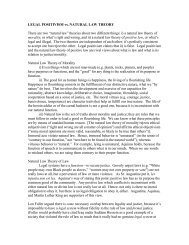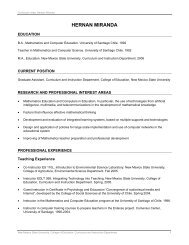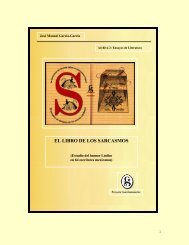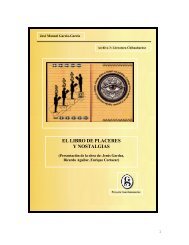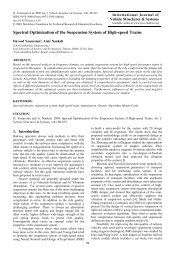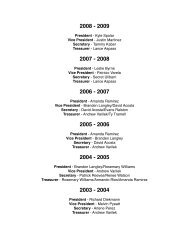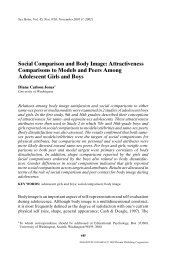The Origins of a Free Press in Prerevolutionary ... - Web Publishing
The Origins of a Free Press in Prerevolutionary ... - Web Publishing
The Origins of a Free Press in Prerevolutionary ... - Web Publishing
You also want an ePaper? Increase the reach of your titles
YUMPU automatically turns print PDFs into web optimized ePapers that Google loves.
155<br />
<strong>of</strong> the civic public. In compar<strong>in</strong>g colonial Virg<strong>in</strong>ia with Habermas’ pre-modern<br />
Western Europe, we can view the royal governor and his counselors (the gentry) as<br />
the colonial equivalent <strong>of</strong> the K<strong>in</strong>g and court, without any truly public discourse at<br />
all <strong>in</strong> the early years <strong>of</strong> the colony. A wider range <strong>of</strong> <strong>in</strong>fluential people (<strong>in</strong>clud<strong>in</strong>g a<br />
newly ris<strong>in</strong>g middl<strong>in</strong>g sort <strong>of</strong> lawyers, tradesmen, and smaller farmers) eventually<br />
underm<strong>in</strong>ed the elite’s political authority. <strong>The</strong> new group used the newly available<br />
pr<strong>in</strong>t discourse to establish their social authority. Out <strong>of</strong> this burgeon<strong>in</strong>g pr<strong>in</strong>t<br />
culture emerged the first actual civic public <strong>in</strong> Virg<strong>in</strong>ia. Its emergence and character<br />
diverge somewhat from the bourgeois transformation Habermas described <strong>in</strong><br />
Western Europe. 73 His theory <strong>of</strong> a civic public assumed—without present<strong>in</strong>g any<br />
solid evidence—that women and the more plebian members <strong>of</strong> society were not<br />
<strong>in</strong>volved. <strong>The</strong> f<strong>in</strong>d<strong>in</strong>gs here suggest that <strong>in</strong> Virg<strong>in</strong>ia some women were <strong>in</strong>deed<br />
<strong>in</strong>volved. 74 Published accounts <strong>of</strong> politics with<strong>in</strong> an emerg<strong>in</strong>g pr<strong>in</strong>t culture are<br />
viewed as a crucial precondition <strong>of</strong> any such civic public. To take part <strong>in</strong> Habermas’<br />
public discourse, however, required tak<strong>in</strong>g part not only <strong>in</strong> pr<strong>in</strong>ted debates but also<br />
<strong>in</strong> oral discussions <strong>in</strong> taverns, c<strong>of</strong>feehouses, and other public spaces, activities that<br />
typically excluded women. 75 Women did form active political groups that could be<br />
considered a female civic public, debat<strong>in</strong>g and tak<strong>in</strong>g action over non-consumption<br />
and non-importation <strong>in</strong> the years lead<strong>in</strong>g to the Revolution. While no evidence <strong>of</strong><br />
73 Rawson, “ ‘Guardians <strong>of</strong> their Own Liberty’,” 79, fn 17, suggested that <strong>in</strong> colonial Virg<strong>in</strong>ia,<br />
rather than a public sphere, there was a tight elite he described as a closed socioeconomic oligarchy<br />
that thought <strong>of</strong> itself as “the public.” He wrote that new economic, political, and cultural elites<br />
used pr<strong>in</strong>t to establish a new authority and Virg<strong>in</strong>ia’s first real public sphere. This research<br />
suggests that <strong>in</strong>stead <strong>of</strong> a pseudo-public, the orig<strong>in</strong>al elite structure relates more to a pre-modern<br />
monarchy, and a totally private discourse. We agree that out <strong>of</strong> the new pr<strong>in</strong>t culture emerges a<br />
public discourse, which he describes as a “sphere.”<br />
74 Craig Calhoun, ed., Habermas and the Public Sphere, (Cambridge: MIT, 1992). This<br />
supports the conclusions <strong>of</strong> Kierner, Beyond the Household, xi, and 213.<br />
75 Sharon Sal<strong>in</strong>ger, <strong>in</strong> Taverns and Dr<strong>in</strong>k<strong>in</strong>g <strong>in</strong> Early America (Baltimore: Johns Hopk<strong>in</strong>s<br />
University <strong>Press</strong>, 2002), noted that women, especially the lower sort, took part <strong>in</strong> dr<strong>in</strong>k<strong>in</strong>g and<br />
tavern discussions, but Sal<strong>in</strong>ger also suggested that gender and class differences were actually<br />
accentuated, not broken down, by tavern custom.



